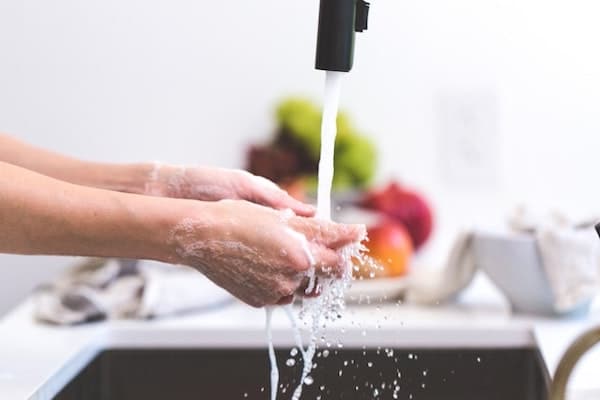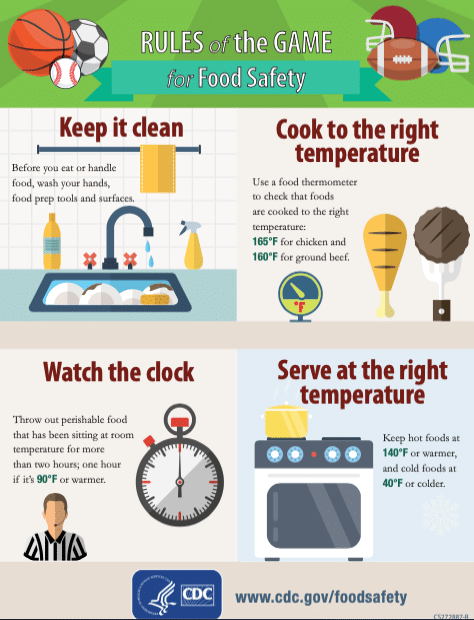Wash hands, wear a mask, put on gloves, sanitize cart, bag your own groceries, drop groceries in sun room, wipe down boxes, wash hands, repackage produce, wash hands, store items in refrigerator or pantry. These are all steps I, along with others, took to ensure “safety” during the early days of the COVID-19 pandemic. Even though I knew the virus was probably not “living” on food packages, precautions seemed reasonable at the time to ensure safe food.

For us, as consumers, where does food safety rank on our daily checklist? How serious are we about doing our part? Food safety is everyone’s responsibility – make it a daily routine. After all, food safety is in our hands … literally.
The Reality Check of Foodborne Illness
During this pandemic, not only have the strengths and weaknesses of our U.S. and global food systems been exposed, but so have the realities of our society’s health. The pandemic has further highlighted the importance of reducing chronic diseases, which put people at higher risk of severe illness from COVID-19. Perhaps, what we have forgotten over time, is why we should take food safety seriously, pandemic or not. Globally, foodborne diseases affect almost one in 10 people in the world with 420,000 deaths annually attributed to these diseases. In the United States, an estimated one in six or 48 million of us get sick, 128,000 are hospitalized, and 3,000 die of foodborne illnesses.1 Anyone can get sick from a foodborne illness but like COVID-19, those at high risk — adults over age 65, children under five, those with compromised immune systems and pregnant women — are more susceptible.2
We may question why we have this continued risk when checks and balances are in place throughout our food system. But as a Council for Agricultural Science and Technology (CAST) report stated over a decade ago, the zero risk of microbiological hazards like bacteria, parasites or viruses is not possible. No method will eliminate all pathogens or toxins from the food chain (“Food Safety and Fresh Produce: An Update,” 2009). Further complicating our safety efforts is the fact that we eat food from around the world, which may or may not have the same protections in place.3
In the United States, about 15% of the food supply is imported from more than 200 countries or territories, including 32% of our fresh vegetables, 55% of our fresh fruit and at least 94% of the seafood that we eat annually. In a perfect world, no one would get sick but that’s not reality. Despite the fact that the United States does have the safest food supply and steps are continuously being taken to improve food quality and safety, those sneaky bacteria strains don’t always comply. Bacteria may survive despite aggressive controls at the processing level, or food may become contaminated somewhere along the way during transport, preparation, cooking, serving or storage.3
The “Need for Speed” in Food Safety

The initiative is based on the following four pillars:
- Enhanced Traceability Through Technology. Emerging technologies, like blockchain, a type of distributed ledger technology (DLT), make it easier to track and trace products through the supply chain from the farm or manufacturer until purchased by us, as consumers, creating the desired transparency of food safety and sustainability practices. This type of technology can be a” game changer” in facilitating more rapid traceback of a contaminated food to its source in the event of a foodborne outbreak. Also, during our current pandemic, we have learned that enhanced traceability can be a tool to identify supply chain disruptions and help mitigate food waste during the initial shutdown of foodservice entities.
- Smarter Tools and Approaches for Prevention and Outbreak Response. More real-time and data-driven approaches can lead to improved partnerships between local health departments, state public health and agriculture departments, and the federal government to more quickly (1) identify the origin of foodborne illnesses, (2) institute food recalls, (3) conduct food inspections, and (4) identify food chemical hazards.
- New Business Models and Retail Modernization. With the surge in online shopping and emergence of new local and regional food distribution models — which have developed even more rapidly during the COVID-19 pandemic — it is all the more important to ensure that food is produced, packaged and transported safety to the consumer. It’s important to remember that whether food is purchased locally or from a national vendor, the same food safety standards need to be in place. New guidance and educational training will continue to evolve as traditional models change.
- Creating a Food Safety Culture. The goal of this new blueprint is to create a food safety culture of responsibility from farm to table. During this pandemic, we’ve witnessed gaps in the accountability of producers providing safe environments for farm and factory workers and we were rightfully appalled. However, we have similar gaps when it comes to accessing and preparing our own food. As the FDA states, we will only lessen or prevent foodborne illnesses when we all accept responsibility for creating a food safety culture.
The Basic Rules are Real

COVID or not, food safety is for real and adopting good habits are the first line of defense to prevent foodborne illness and potential cross-contaminated. Here are the must-do rules:
- Clean: Wash hands before, during and after food preparations. Dry hands on a separate towel (not the one for dishes) or a clean paper towel. Wash all produce (whether you eat the skin or not) thoroughly under running water before preparing and/or eating. This includes produce grown at home or bought from a grocery store or farmers’ market. If the produce surface is rough like an avocado or melon, use a vegetable brush to lightly scrub the surface without bruising.
- Separate: Raw meat, poultry, seafood and eggs can spread germs.6 Always use separate cutting boards for fresh meat and produce. The two shall never meet!
- Cook: Buy an instant read food thermometer and use it to make sure foods are cooked to an internal temperature that kills germs. Hot foods need to be at least 140 degrees. Reheat leftovers at internal temperature of 165 degrees.
- Chill: Refrigerate perishable food and leftovers within two hours. Chill within one hour if room or outside temperature is above 90 degrees. Refrigerate leftovers in shallow pans to allow for quick and even cooling. Cooling to room temperature on a counter top before chilling is not safe regardless of what you’ve been told.7
Be responsible! Food safety is in your, our and my hands. Accept the challenge.
References:
1. “Employee Health and Food Safety Checklist for Human and Animal Food Operations During the COVID-19 Pandemic,” Food and Drug Administration (FDA) and Occupational Safety and Health Administration (OSHA), August 11, 2020.
2. “Food Safety Education Month,” Centers for Disease Control and Prevention, August 25, 2020.
3. “About Foodborne Illness,” Partnership for Food Safety Education, 2020.
4. “New Era of Smarter Food Safety Blueprint: Modern Approaches for Modern Times,” U.S. Food & Drug Administration, July 13, 2020.
5. “Consumer Survey: Trends, Habits and Attitudes Related to Food Safety,” Food Insight, Sept. 2, 2020.
6. “Foods That Can Cause Food Poisoning,” Centers for Disease Control and Prevention, June 30, 2020.
7. “4 Steps to Food Safety, Chill: Refrigerate and Freeze Food Properly,” U.S. Department of Health & Human Services.

